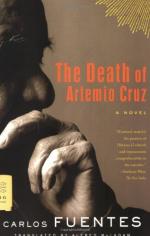|
This section contains 620 words (approx. 2 pages at 400 words per page) |

|
The Death of Artemio Cruz Summary & Study Guide Description
The Death of Artemio Cruz Summary & Study Guide includes comprehensive information and analysis to help you understand the book. This study guide contains the following sections:
This detailed literature summary also contains Related Titles and a Free Quiz on The Death of Artemio Cruz by Carlos Fuentes.
The Death of Artemio Cruz is a sweeping novel about 20th century Mexico, viewed through the prism of Artemio Cruz's life. Cruz is an idealistic young soldier during the Mexican Revolution dedicated to redistribution of land so that peasants may enjoy a decent life. By 1919, the successful revolution has deteriorated into a series of confusing and bloody skirmishes between rival rebel factions that won't truly end until 1942. Cruz betrays a fellow soldier and blackmails the man's sister into marriage, ensuring his position in a wealthy land-owning family. He quickly becomes a wealthy, arrogant, unprincipled scoundrel—the exact types he fought against during the revolution. Throughout his long life, Cruz continues to accumulate wealth by way of corruption, betraying his family, lovers and former comrades alike. Eventually, Cruz's lust for wealth results in the death of his only son, Lorenzo.
Although it is not revealed until almost the end of the novel, Cruz is the illegitimate son of a handsome, wealthy young heir to a plantation or hacienda. The arrogant young man raped Cruz's mother, a young mulatto slave. After Cruz's birth, his mother is beaten and forced to leave. Cruz is raised by his uncle Lunero, a man he would defend to the death if necessary.
After Lunero's death, Cruz joins the revolutionary movement, dedicated to wresting the land from a few wealthy individuals and allowing each peasant enough fields to feed his family. Cruz's first love, Regina, is hanged by the opposing forces. By 1919, Porfirio has been defeated and the country seems enmeshed in permanent, bloody confusion. When Cruz is imprisoned with an idealistic young officer, Gonzolo Bernal, he gains valuable information about the man's personal life. Cruz makes no effort to save the man, who is executed by a firing squad.
Using deceit and deception, Cruz parlays the information he gained from Bernal into a loveless marriage with the officer's young sister, Catalina. Because women are not allowed to own property, Cruz inherits all the family's wealth in a short time, when Don Bernal, the father, dies. There is little available cash, but a vast fortune in land. Cruz soon expands the family's holdings through trickery and violence.
Cruz buys a newspaper in Mexico City and uses the power and voice it gives him to expand his business holdings. He uses the paper to blackmail business competitors and destroy uncooperative politicians. Cruz begins to act as an intermediary, facilitating corrupt business deals to sell the country's natural resources to U.S. businessmen—for a hefty fee, of course.
Cruz sends his only son, Lorenzo, to manage the family estate at Cocuya at the age of 12, partly to spite Catalina, who adores the boy. At 17, idealistic and determined to join the fight against the Fascists, Lorenzo books a passage to Spain. The boy is killed in the fighting, leaving Cruz with only a daughter, Teresa, whom he disdains. On his deathbed, Cruz torments both women, lying to them about the location of his will. In fact, he has left the bulk of his estate to his loyal aide, Padilla.
The seamless transformation from an impoverished, idealistic youth to a corrupt, decadent middle age and the turbulence of Mexican history are the primary messages of the novel. Fuentes suggests that only those who die young or live in abject poverty manage to retain their idealism.
The author ably uses Cruz's free-ranging, disembodied consciousness as he dives to explore different points of view and language styles throughout the novel. Fuentes uses metaphor and juxtaposition like a poet, interspersing vivid action scenes with Cruz's stream-of-consciousness thoughts. Sam Hileman ably translates Fuentes' prose, which includes lengthy sections without punctuation, and unusual passages told in the second person.
Read more from the Study Guide
|
This section contains 620 words (approx. 2 pages at 400 words per page) |

|



